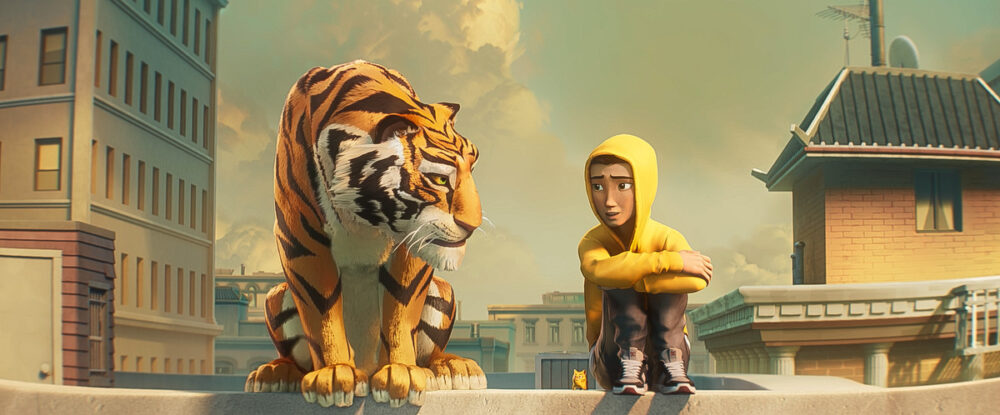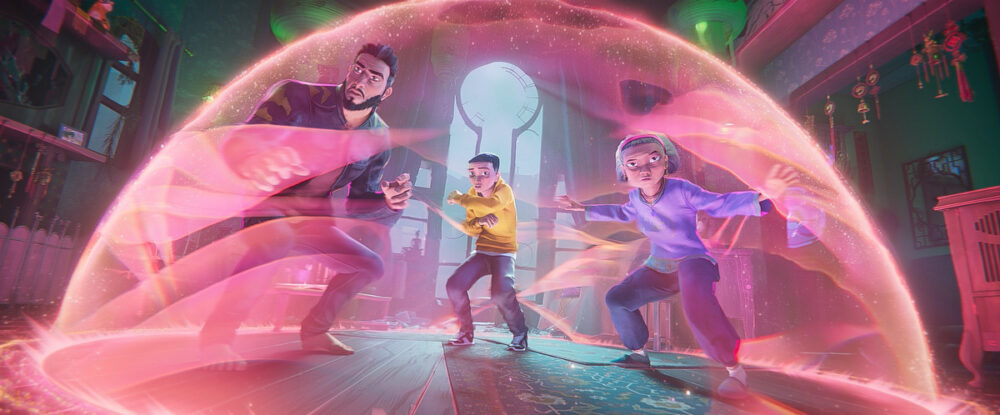|
Getting your Trinity Audio player ready...
|
Across countless cultures, mythology’s millennia-long dalliance with astronomy and astrology has begotten some of humanity’s most cherished stories. The Chinese zodiac, which oscillates through a 12-year cycle as opposed to its 12-month variant in the West, effortlessly retains its association with relevant myths, irrespective of the era.
Paramount+’s upcoming feature film The Tiger’s Apprentice perfectly encapsulates this concept as an animated adaptation of the renowned 2003 novel by Laurence Yep. Besides possessing the narrative DNA of its source material, the new animated feature also has the privilege of emerging in an era where positive representation of Asian and Asian American culture is at an all-time high. Although Asian culture is at the film’s forefront, director Raman Hui believes that The Tiger’s Apprentice’s strength lies in its universality.

“The Tiger’s Apprentice speaks to any kids and families with any cultural background, not just [an] Asian background,” says Hui. “While the Asian families can relate to the heritage in the story that they are familiar with, the non-Asian families will get to see a different culture that they can appreciate and understand.”
‘Being Chinese American and having lived in San Francisco for over 20 years, I could picture all the specific elements in the story that happened there. The cultural background and the values of the characters inspired me and spoke to me.’
— Director Raman Hui
The new CG-animated feature follows the journey of Tom Lee (Brandon Soo Hoo), whose grandmother is grooming him to inherit her position as guardian of an ancient and powerful artifact known as the coral rose. Slain in an attack that threatens the safety of her grandson and the coral rose, Tom’s grandmother cedes her role of guardian and mentor to her ally, Mr. Hu (Henry Golding). Armed with the ability to transform into an avatar of a tiger from the Chinese zodiac, Mr. Hu develops Tom’s latent strengths to become the eponymous tiger’s apprentice.
Although rife with fantastical elements, Hui felt a personal connection to The Tiger’s Apprentice that grounded him throughout its production. “Being Chinese American and having lived in San Francisco for over 20 years, there is always a special place in my heart for San Francisco Chinatown,” says Hui. “And I could picture all the specific elements in the story that happened there. The cultural background and the values of the characters inspired me and spoke to me.”
Earning Your Stripes
Like studying at the feet of a martial arts master, the process of adapting The Tiger’s Apprentice novel was lengthy and required several years of intense development. “The book by Laurence Yep was first published in 2003 and was in movie development soon after by Jane Startz,” says Hui.
Mirroring its protagonist during its initial phase of development, The Tiger’s Apprentice was originally in the hands of a different master, since the film was first optioned by and slated to debut on Cartoon Network. Eventually, that iteration of The Tiger’s Apprentice failed to find its footing, leading to more than a decade of relative inactivity for the intellectual property. “I joined the project in 2019 when the script was ready for preproduction,” says Hui. “During preproduction, we kept working on the script under the supervision of Bob Persichetti (Spider-Man: Across the Spider-Verse) and Latifa Ouaou (Minions: The Rise of Gru).
“The production part, guided by Sandra Rabins, took around two-and-a-half years to finish,” says Hui. “And the post-production, including the music by Steve Jablonsky (DC League of Super-Pets), finished in mid-2023. From pre-production to finishing [the film] altogether took about four years.”
The process of realizing author Laurence Yep’s dream of a cadre of warriors powered by the Chinese zodiac required the proverbial stars to align, as evidenced by the abundance of A-list voice talent within The Tiger’s Apprentice’s cast. “I had a blast working with the amazing cast,” says Hui. “They added beautiful layers and dimensions to the characters with humor and emotions.”
As with any film, the chemistry shared between leads is an essential element for success, and according to Hui, the men behind the titular tiger and his apprentice provided the movie with a rich emotional core. “Henry Golding gave us the powerful yet sensitive, tough yet fun Hu the Tiger, and Brandon Soo Hoo played the troublemaking but good-hearted apprentice Tom,” says Hui.
Aside from boasting enough star power to make an astrology aficionado’s knees wobble, The Tiger’s Apprentice is a shining example of representation, as members of the AAPI (Asian American and Pacific Islander) community comprise a majority of the cast. “Sandra Oh gave us a sympathetic, magical and spectacular Mistral the Dragon,” says Hui. “And Michelle Yeoh gave us the complicated, threatening and whimsical evil force, Loo. You wouldn’t want to disagree with Michelle.”

The Eye of the Tiger
It’s common for martial artists to attribute their victories to the power of positive visualization, and for the crew behind The Tiger’s Apprentice, a clear vision of success was equally crucial in crafting a mystical world of kung fu practitioners. “Our production design team, led by Christophe Lautrette (Rumble), paid extra attention to details to make what is on screen authentic to the culture and background of the story,” says Hui. “We worked great as a team, and I was happy to be the go-to person for any questions regarding the culture. For example, how would a Chinese grandmother show her grandson love without saying, ‘I love you’? The answer is she may pinch his cheek or feed him with a lot of food to express that affection.”
Although visualization is a pivotal portion of the equation, the execution of one’s intent is what produces results. Helping to shepherd The Tiger’s Apprentice from the theoretical realm to tangibility was a team of expertly talented artists. “It took close to 80 animators to animate the movie,” says Hui. “The majority of the animators animated in France. We also had animators from Spain, England, Belgium and Canada work on it remotely.”
Wrangling such a massive stable of creators is an art in itself, and Hui is quick to credit his colleagues who helped compose the mosaic of talent behind The Tiger’s Apprentice. “David Nasser and Yannick Honore supervised the animation across all these countries,” says Hui. “I was grateful for how much they cared about the characters in the movie and how they brought them to life with hilarious, energetic and touching acting. I also learned to speak a little French and a very little Thai, while I taught the animators some simple Chinese.”
The Tiger’s Apprentice possesses a spectacle and scale on par with the kung fu films of yesteryear and modern Marvel movies, but at its core it’s a relatable coming-of-age story. Despite his irrepressible pride for the breathtaking work his team poured into the film on a visual and narrative level, Hui believes The Tiger’s Apprentice’s effervescent tone is what audiences will identify with and enjoy the most. “I hope the audience will have fun and feel uplifted watching how Hu the Tiger, and his friends help Tom grow to become a wonderful apprentice,” says Hui.
The Tiger’s Apprentice premieres Friday, February 2 on Paramount+.











 Win a Funko X Lilo & Stitch Prize Pack!
Win a Funko X Lilo & Stitch Prize Pack! 
